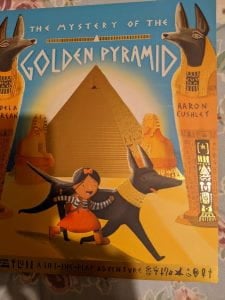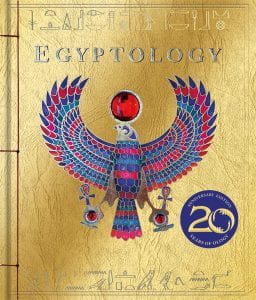This year has seen the centenary of the discovery of Tutankhamun’s tomb, as well as the bi-centenary of the finding of the Rosetta stone and the translation of hieroglyphs by Jean-Francois Champollion. This has given me the impetus to compile this list of books featuring that fascinating civilization. It is something that I have wanted to do for a long time. However I am amazed by the sheer volume of books about the subject. Mainly I have kept to those published in the last year or so, but I have included some long term favourites from my own library. I hope you enjoy reading some of them
“The Mystery of the Golden Pyramid” by Adela Norfan and Aaron Cushley is a delightful introduction to Ancient Egypt. When Sophie moves to Egypt, she is surprised to find a dog in her bedroom, but this is a talking dog who gives her a quest to find and return four lost amulets to the tomb of King Nebra. It is full of action and humour and will appeal to all KS1 children. The illustrations are excellent, with some great ‘lift-the-flap’ elements.
Ancient Egypt. When Sophie moves to Egypt, she is surprised to find a dog in her bedroom, but this is a talking dog who gives her a quest to find and return four lost amulets to the tomb of King Nebra. It is full of action and humour and will appeal to all KS1 children. The illustrations are excellent, with some great ‘lift-the-flap’ elements.
“The Curse of the Tomb Robbers” by Andy Seed and James Weston Lewis is an exquisitely illustrated story of intrigue and tomb robbery, in which two children are able to foil the robbers and bring them to justice. It highlights the importance of reading the hieroglyphs and also the respect that was given to the dead, by the Egyptians.
intrigue and tomb robbery, in which two children are able to foil the robbers and bring them to justice. It highlights the importance of reading the hieroglyphs and also the respect that was given to the dead, by the Egyptians.
“Secrets of the Dead” by Matt Ralphs and Gordy Wright is produced by the British Museum and looks at the various forms of mummification found around the world. Egypt is only one of those places, but the chapter in this book looks at the methods used and at some famous examples such as Tutankhamun and Ramses II. The book makes for a fascinating read.
British Museum and looks at the various forms of mummification found around the world. Egypt is only one of those places, but the chapter in this book looks at the methods used and at some famous examples such as Tutankhamun and Ramses II. The book makes for a fascinating read.
“The magnificent book of Treasures: Ancient Egypt” by Philip Steele and Eugenia Nobati. I have written a full blog post about this book and you can see it by looking for the title on the blog site. It is a gorgeous book.
 “King Tutankhamun tells all” by Chris Naunton and Guilherme Karsten is written by one of our most well-known and knowledgeable Egyptologists. The illustrations are cartoon style and full of colour and is written in the form of a memoir by the dead Pharaoh. There is a great deal of humour in the way that it is written, but it is still full of information about the king and also Ancient Egypt itself.
“King Tutankhamun tells all” by Chris Naunton and Guilherme Karsten is written by one of our most well-known and knowledgeable Egyptologists. The illustrations are cartoon style and full of colour and is written in the form of a memoir by the dead Pharaoh. There is a great deal of humour in the way that it is written, but it is still full of information about the king and also Ancient Egypt itself.
“Mummies Unwrapped” by Tom Froese is written in conjunction with the British Museum and is a fascinating look at the various processes that a mummy underwent; asking many of the questions that young people want to know.. The illustrations are bright clear and have elements of humour, which really adds to the enjoyment. The cover is gold, which will add to the attraction for the intended audience.
British Museum and is a fascinating look at the various processes that a mummy underwent; asking many of the questions that young people want to know.. The illustrations are bright clear and have elements of humour, which really adds to the enjoyment. The cover is gold, which will add to the attraction for the intended audience.
 “Egyptology” by Dugald Steer is the first in a series of truly sumptuous books, full of illustrations, lift the flaps, added artifacts and information about a range of topics. this book has a gold cover and really gives the reader a sense of the grandeur that was found in Egyptian tombs. Whilst this is not a new title, it is one that should be the basis of anyone’s collection about Egypt.
“Egyptology” by Dugald Steer is the first in a series of truly sumptuous books, full of illustrations, lift the flaps, added artifacts and information about a range of topics. this book has a gold cover and really gives the reader a sense of the grandeur that was found in Egyptian tombs. Whilst this is not a new title, it is one that should be the basis of anyone’s collection about Egypt.
 “Egyptian diary: The Journal of Nakht” by Richard Platt and David Parkins is the story of a young boy living in Memphis with his family and how he helps foil a gang of tomb robbers and eventually get to meet the Pharaoh Hatshepsut, only to discover that they are a woman (one of very few female pharaohs). this is a large size book with some fabulous illustrations. Since its publication in 2005 it has become a staple of all school libraries.
“Egyptian diary: The Journal of Nakht” by Richard Platt and David Parkins is the story of a young boy living in Memphis with his family and how he helps foil a gang of tomb robbers and eventually get to meet the Pharaoh Hatshepsut, only to discover that they are a woman (one of very few female pharaohs). this is a large size book with some fabulous illustrations. Since its publication in 2005 it has become a staple of all school libraries.
 “Marcy and the Riddle of the Sphinx” by Joe Todd Stanton is the second tale in the “Brownstone’s Mythical collection” series and follows the adventures of Marcy, the daughter of the original hero Arthur, as she attempts to save her father from the clutches of the Great Sphinx. Children will love the graphic novel format and the fast pace of the action.
“Marcy and the Riddle of the Sphinx” by Joe Todd Stanton is the second tale in the “Brownstone’s Mythical collection” series and follows the adventures of Marcy, the daughter of the original hero Arthur, as she attempts to save her father from the clutches of the Great Sphinx. Children will love the graphic novel format and the fast pace of the action.
“I was there: Tutankhamun’s Tomb” by Sue Reid is a great read for younger audiences. It is based on the fact that a young boy was involved in finding the stairs which led to the tomb discovery. it is full of action, villains and of course introduces the audience to Howard Carter and his patron Lord Caernarvon.
audiences. It is based on the fact that a young boy was involved in finding the stairs which led to the tomb discovery. it is full of action, villains and of course introduces the audience to Howard Carter and his patron Lord Caernarvon.
This is just the first section of this rather mammoth post, but I found it o difficult to cut down on the titles to be included. Join me again for part two of this collection.
